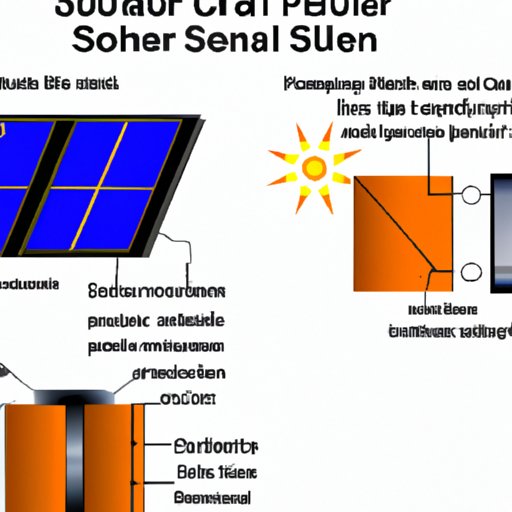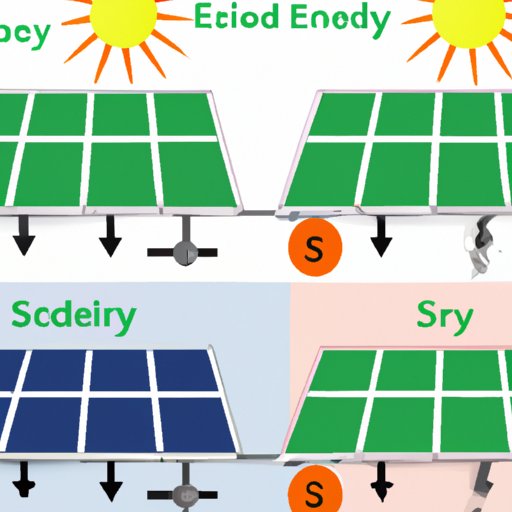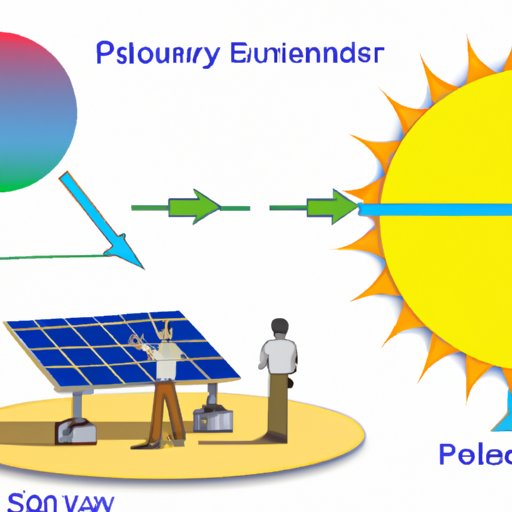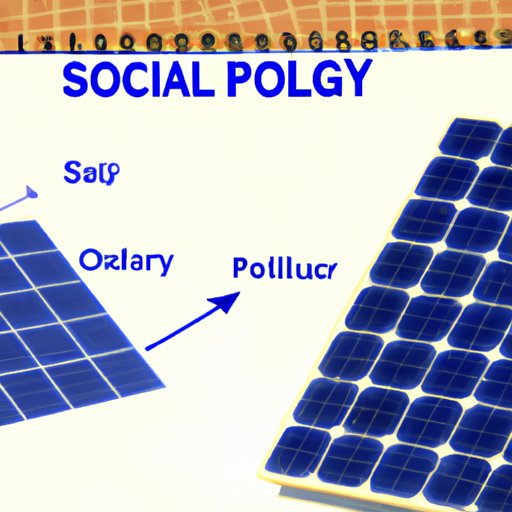Introduction
A solar cell is an electrical device that converts sunlight directly into electricity. It is made up of a semiconductor material, such as silicon, which absorbs the sun’s energy and converts it into usable electrical power. This article will explore how a solar cell works, from its components to the process of converting solar energy into electricity. It will also examine the environmental impact, different types of solar cells, and the economics of solar energy production.
Explaining How a Solar Cell Works Through an Analogy
To understand how a solar cell works, it helps to think of it as a miniature electrical power plant. Just like a power plant, a solar cell is made up of several parts that work together in order to generate electricity. In a power plant, these parts include a fuel source, such as coal or natural gas, a turbine, and a generator. In a solar cell, the parts are the semiconductor material, the photovoltaic effect, and the electrical circuit.
The analogy helps to illustrate how the components of a solar cell interact with each other. The semiconductor material is analogous to the fuel source in a power plant; it absorbs the sun’s energy and converts it into usable electrical power. The photovoltaic effect is analogous to the turbine in a power plant; it is the process by which the solar energy is converted into electricity. Finally, the electrical circuit is analogous to the generator in a power plant; it is the component that collects and stores the electricity produced by the solar cell.

Breaking Down the Components of a Solar Cell and How They Interact
Now that we have an understanding of how a solar cell works through an analogy, let’s take a closer look at the components of a solar cell and how they interact with each other. The most important component of a solar cell is the semiconductor material, which is typically made of silicon. When exposed to light, the electrons in the silicon become energized and move around, creating an electric current. This current is then collected and stored in an electrical circuit.
The photovoltaic effect is the process by which the solar energy is converted into electricity. When the photons in sunlight hit the semiconductor material, they excite the electrons and cause them to move around. This creates an electric field, which causes the electrons to flow through the electrical circuit, producing electricity.
Examining the Impact of Solar Energy on the Environment
Solar energy has many positive environmental impacts. It is a renewable energy source, meaning it does not deplete natural resources like fossil fuels do. Additionally, solar energy does not produce harmful emissions or pollutants that can damage the environment. As a result, solar energy is an important part of the effort to reduce global warming and climate change.
However, there are some potential drawbacks to solar energy. The cost of solar technology can be prohibitively expensive for many households and businesses. Additionally, solar panels can take up large amounts of space, making them impractical for certain applications. Finally, solar energy is only available when the sun is shining, so it cannot be used as a reliable source of energy at all times.

Comparing Different Types of Solar Cells and Their Efficiencies
There are several different types of solar cells available, each with their own advantages and disadvantages. Monocrystalline solar cells are the most efficient type, but they are also the most expensive. Polycrystalline solar cells are less efficient and cheaper, but they are more durable and can withstand extreme temperatures. Thin-film solar cells are the least efficient type, but they are also the most affordable.
The efficiency of a solar cell is determined by its ability to convert sunlight into electricity. Monocrystalline solar cells have the highest efficiency ratings, followed by polycrystalline solar cells and thin-film solar cells. The higher the efficiency rating, the more electricity a solar cell can produce.

Demonstrating the Process of Converting Solar Energy Into Electricity
Once the sunlight hits the solar cell, the photovoltaic effect occurs and the electrons are excited. This creates an electric field, which causes the electrons to flow through the electrical circuit and produces electricity. This electricity can then be used to power homes and businesses, or it can be stored in batteries for later use.
Photovoltaic cells are an important part of the process of converting solar energy into electricity. These cells are made up of two layers of semiconductor material, usually silicon, that are sandwiched together. When sunlight hits the photovoltaic cell, the electrons become excited and move around, creating an electric field and producing electricity.

Investigating the Economics of Solar Energy Production
The cost of solar energy production has decreased significantly over the years due to advances in technology and manufacturing processes. Additionally, there are a number of economic incentives for individuals and businesses who choose to invest in solar energy production. These incentives include tax credits, grants, and rebates that can help reduce the cost of solar energy production.
Despite the economic benefits, solar energy production still remains relatively expensive compared to other sources of energy. Additionally, the upfront cost of installing solar panels can be prohibitively expensive for many households and businesses. However, the long-term savings on electricity bills can make solar energy production a worthwhile investment.
Exploring the Future of Solar Power Technology
As solar energy technology continues to advance, the efficiency and cost of solar energy production are expected to increase. Scientists are developing new materials and techniques that could significantly improve the efficiency of solar cells. Additionally, researchers are exploring ways to reduce the cost of solar energy production, making it more accessible to everyone.
In the future, solar energy could become the primary source of energy for many households and businesses. With advances in technology and a greater focus on sustainability, solar energy could become a viable and affordable alternative to traditional sources of energy.
Conclusion
In conclusion, this article has explored how a solar cell works, from its components to the process of converting solar energy into electricity. It has also examined the environmental impact, different types of solar cells, and the economics of solar energy production. Finally, it has looked at the potential of future solar power technology and the role it could play in providing clean, renewable energy for the world.
Solar energy is an important part of the fight against climate change and global warming. By understanding how solar cells work and exploring the potential of solar energy, we can make informed decisions about our energy use and help create a more sustainable future.
(Note: Is this article not meeting your expectations? Do you have knowledge or insights to share? Unlock new opportunities and expand your reach by joining our authors team. Click Registration to join us and share your expertise with our readers.)
